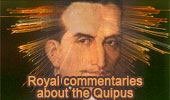The Quipus and The Royal Commentaries of the Inca
In 1609, the Inca Garcilaso de la Vega published the
first volume of his Royal Commentaries of the Incas in
Lisbon. He wrote:
 The
word quipu means both knot or to knot; it
was also used for accounts, because they were kept by
means of the knots tied in a number of cords of
different thicknesses and colors, each one of which had
a special significance. Thus, gold was represented by a
gold cord, silver by a white one, and fighting men by a
red cord. The
word quipu means both knot or to knot; it
was also used for accounts, because they were kept by
means of the knots tied in a number of cords of
different thicknesses and colors, each one of which had
a special significance. Thus, gold was represented by a
gold cord, silver by a white one, and fighting men by a
red cord.
When their
accounts had to do with things that have no color - such
as grain and vegetables - they were classified by
categories, and, in each category, by order of
diminishing size. Thus, to furnish an example, if they
had had to count the various types of agricultural
production in Spain, they would have started with
wheat, then rye, then peas, then beans, and so forth. In
the same way, in order to make an inventory of the arms
of the imperial army, they first counted the arms that
were considered to belong in a superior category, such
as lances, then javelins, bows and arrows, hatchets and
maces, and lastly, slings, an any other arms that were
used. In order to ascertain the number of vassals in the
Empire, they started with each village, then with each
province: the firs cord showed a census of men over
sixty, the second, those between fifty and sixty, the
third, those from forty to fifty, and so on, by decades,
down to the babes at the breast.
Occasionally
other, thinner, cords of the same color, could be seen
among one of these series, as though they represented an
exception to the rule; thus, for instance, among the
figures that concerned the men of such and such an age,
all of whom were considered to be married, the thinner
cords indicated the number of widowers of the same age,
for the year in question: because, as I explained
before, population figures, together with those of all
the other resources of the Empire, were brought up to
date every year.
According to
their position, the knots signified units, tens,
hundreds, thousands, ten thousands and, exceptionally,
hundred thousands, and they were all as well aligned on
their different cords as the figures that an accountant
sets down, column by column, in his ledger. Indeed,
those men, called quipucamayus, who were in
charge of the quipus, were exactly that, imperial
accountants.
The number
of quipucamayus scattered throughout the Empire, was
proportional to the size of each place. Thus the
smallest villages numbered four, and others twenty, or
even thirty. The Incas preferred this arrangement. even
in places where one accountant would have sufficed, the
idea being that, if several of them kept the same
accounts, there was less risk that they would make
mistakes.
Every
year, an inventory of all the Inca's possessions was
made. Nor was there a single birth or death, a single
departure or return of a soldier, in all the Empire,
that was not noted on the quipus. And indeed, it may be
said that everything that could be counted, was counted
in this way, even to battles, diplomatic missions, and
royal speeches. But since it was only possible to record
numbers in this manner, and not words, the quipucamayus
assigned to record ambassadorial missions and speeches,
learned them by heart, at the same time that they noted
down the numbers, places and dates on their quipus; and
thus, from father to son, they transmitted this
information to their successors. The speeches exchanged
between the Incas and their vassals on important
occasions, such as the surrender of a new province, were
also transmitted to posterity by the amautas, or
philosophers, who summarized them in simple, clear
fables, in order that they might be implanted by word of
mouth in the memories of all the people from those at
court to the inhabitants of the most remote hamlets. The
harauicus, or poets, also composed poems based on
diplomatic records and royal speeches. These poems were
recited for a great victory or festival, and every time
a new Inca was knighted.
When the
curacas and dignitaries of a province want to know some
historical detail concerning their predecessors, they
asked these quipucamayus, who were, in other words, not
only the accountants, but also the historians of each
nation. The result was that the quipucamayus never let
their quipus out of their hands, and they kept passing
their cords and knots through their fingers so as not to
forget the tradition behind all these accounts. In fact,
their responsibility was so great and so absorbing, that
they were exempted from all tribute as well as from all
other kinds of service.
All laws,
ordinances, rites, and ceremonies throughout the Empire
were recorded by these same means.
When my
father's Indians came to town on Midsummer's Day to pay
their tribute, they brought me the quipus; and the
curacas asked my mother to take note of their stories,
for they mistrusted the Spaniards, and feared that they
would not understand them. I was able to reassure them
by re-reading what I had noted down under their
dictation, and they used to follow my reading, holding
on to their quipus, to be certain of my exactness; this
was how I succeeded in learning many things quite as
perfectly as did the Indians.

|